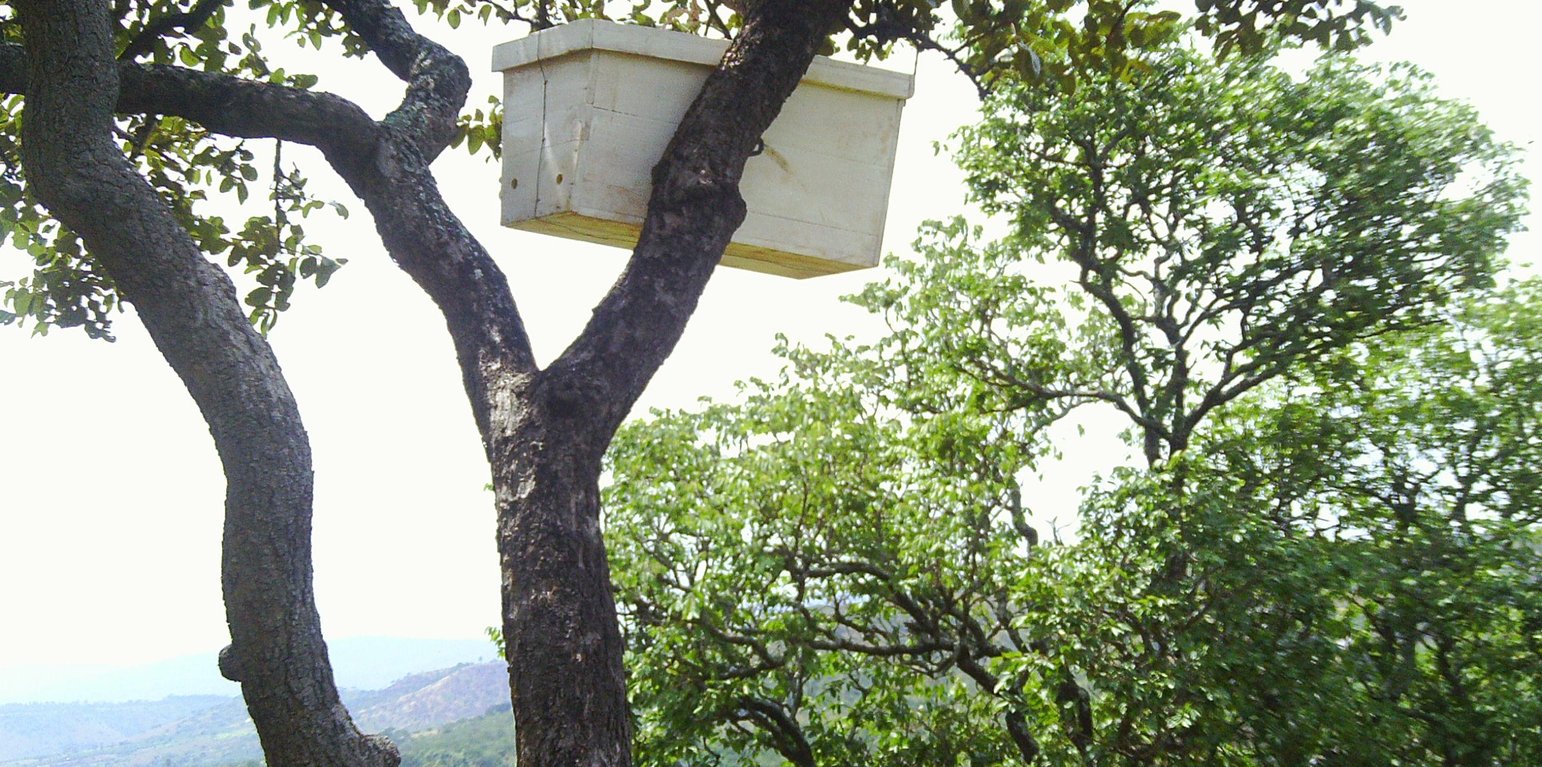Natural forest conservation using apiaries
(Tanzania, United Republic of)
Utunzaji misitu kwa kufuga nyuki (swahili),
Description
Establishment of apiaries in natural forests to retard forest mismanagement and improve honey production
This technology has been practiced in Ngara region for the last 50 year and involves construction and upkeep of apiaries for honey and related goods production. The apiaries are constructed by farmers (traditional) or purchased (modern box hieves) and then positioned in a designated forest area that is away from settlements and public places. The apiaries should be hanged on a strong branches of trees with good shade and the honey production process takes from 9 to 12 months.
Purpose of the Technology: It is recommended to apply this technology in the forest that is exposed to deforestation as apiaries help to enhance forest protection. The establishment of apiaries help to improve management of the natural forest while increasing production of honey. This will contribute to the better livelihood of the community and environmental wellbeing.
Establishment / maintenance activities and inputs: The described technology covers area of enclosed 4 hectares of natural forest and establishment of 365 apiaries (338 traditional, 27 box hives); the group of practitioners consist of 10 members (7 male and 3 female). The establishment procedures require: a) identification of forest at risk of degradation, b) ermarcation of the apiary forest, c) creefing of fire breaks d) reparations for and hanging the beehives (traditional and box hives). Maintanance acivities include a) regular slashing of grasses and bushes around the trees with hives b)grading with hand hoes the fire breaks/ roads around the entire forest for fire protection before each dry season c) cleaning of hives,repairs and harvest honey with bee protectives (bee smoker,bee veils,gloves) to eliminate the risks of fire in the forest.Patrol and guard tresspassers d) monitoring pests and diseases
Natural / human environment: Natural occuring tree species include: Combretus spp., Albizia spp., Parinari spp., Pericopsis spp. and Eucalyptus woodlots. Grazing areas are nearby but restricted by village by laws to tress pass in the forest apiary
The aipiaries should be located near permanent water sources because bees use water for honey production and cooling in the hives. Farmers with bee hives become more committed to protect their forest when they hang beehives in the area. Honey is harvested for consumption, trade and medicinal mixtures
The land users are small scale subsistance farmers with poor to average income/wealth,organised as a group of 10 farmers. the population density is between 200-500 people per square km and anual population growth at 2-3% Land ownership is both individual and communal but there are natural forestl areas owned communally through village governments where groups may access temporarily by request to establish environmental friendly activities such as forest apiaries.
Location
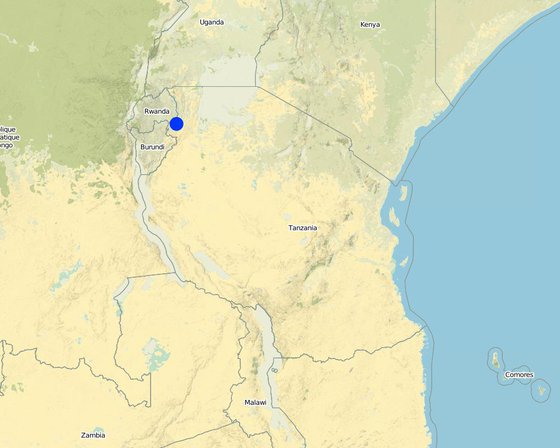
Location: Ngara District, Tanzania, Tanzania, United Republic of
No. of Technology sites analysed:
Geo-reference of selected sites
Spread of the Technology: evenly spread over an area (approx. < 0.1 km2 (10 ha))
In a permanently protected area?:
Date of implementation: more than 50 years ago (traditional)
Type of introduction
-
through land users' innovation
-
as part of a traditional system (> 50 years)
-
during experiments/ research
-
through projects/ external interventions
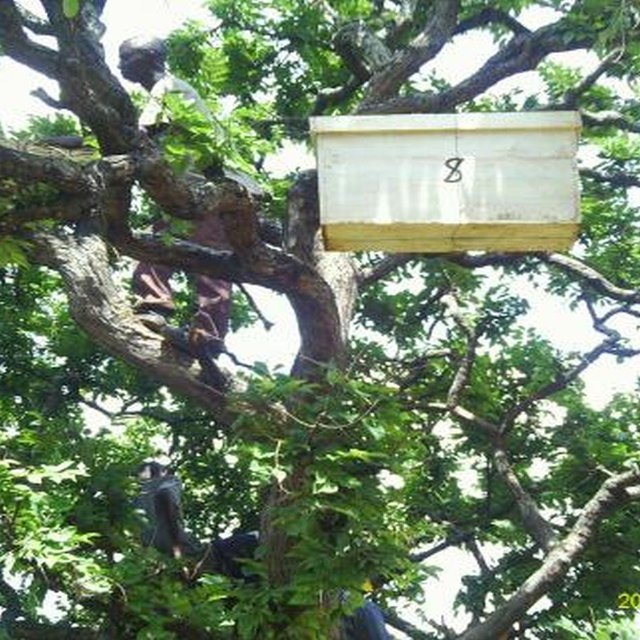
Inspection of apiaries hanged on the tree (Ileta Philip (P.O. BOX 30, Ngara))
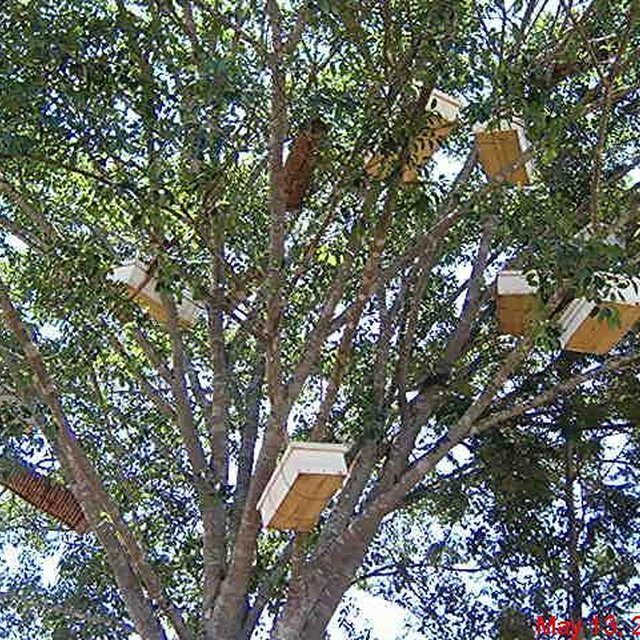
FOREST APIARY A good branched conserved Fig tree has more than 10 beehives in Ngara TZ (Philip Ileta)
Classification of the Technology
Main purpose
-
improve production
-
reduce, prevent, restore land degradation
-
conserve ecosystem
-
protect a watershed/ downstream areas – in combination with other Technologies
-
preserve/ improve biodiversity
-
reduce risk of disasters
-
adapt to climate change/ extremes and its impacts
-
mitigate climate change and its impacts
-
create beneficial economic impact
-
create beneficial social impact
Land use
-
Forest/ woodlandsProducts and services: Fuelwood, Other forest products, Grazing/ browsing, Nature conservation/ protection
Water supply
-
rainfed
-
mixed rainfed-irrigated
-
full irrigation
Purpose related to land degradation
-
prevent land degradation
-
reduce land degradation
-
restore/ rehabilitate severely degraded land
-
adapt to land degradation
-
not applicable
Degradation addressed
-
biological degradation - Bc: reduction of vegetation cover, Bh: loss of habitats, Bq: quantity/ biomass decline, Bf: detrimental effects of fires, Bs: quality and species composition/ diversity decline
SLM group
-
area closure (stop use, support restoration)
-
beekeeping, aquaculture, poultry, rabbit farming, silkworm farming, etc.
SLM measures
-
agronomic measures - A7: Others
-
management measures - M3: Layout according to natural and human environment
Technical drawing
Technical specifications
Layout of natural apriaries (beehives BH) placed on the trees (good braches with shade), access path and firebreak and live fence.
Ngara district Council
Date: 15 May 2012
Technical knowledge required for field staff / advisors: moderate (To extend knowledge/skills on modern/sustainable beekeeping)
Technical knowledge required for land users: moderate (To add/improve skills on existing indigineous knowledge)
Main technical functions: indirectly minimize deforestation, indirectly increase of biomass
Secondary technical functions: promotion of vegetation species and varieties (quality, eg palatable fodder), control of fires, reduction of dry material (fuel for wildfires), spatial arrangement and diversification of land use
Aligned: -along boundary
Vegetative material: O : other
Change of land use practices / intensity level: Establishment of bee apiaries in forest to add on value/productivity and optimise diversification of land use
Layout change according to natural and human environment: The site should be away at least 400m from nearby settlements/public places
Major change in timing of activities: Twice per year Feb and Sept during honey harvesting season management activities are at their peak.
- Fire breaks established in June /July before dry season commence
Control / change of species composition: Various flora and fauna organisms get time to establish and grow well due to absence of burning
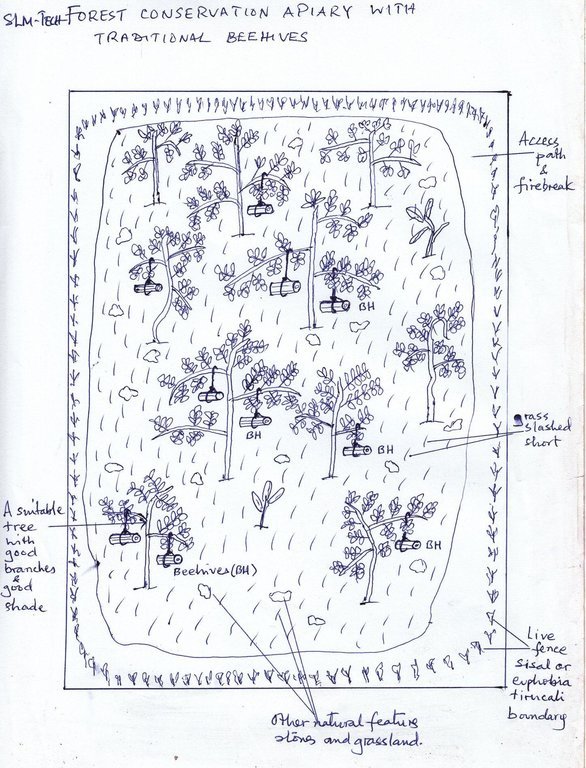
Author: Ileta Philip, P.O BOX 30, Ngara
Establishment and maintenance: activities, inputs and costs
Calculation of inputs and costs
- Costs are calculated:
- Currency used for cost calculation: USD
- Exchange rate (to USD): 1 USD = n.a
- Average wage cost of hired labour per day: 1.25
Most important factors affecting the costs
High prices of equpipment an (especially box hives) and labour
Establishment activities
-
Purchase of hives and binding wires (Timing/ frequency: Before dry season)
-
Purchase of beekeeping protectives (Timing/ frequency: Routine)
-
Slashing, screefing bushes and tall grasses; planting hedge around forest boundary (Timing/ frequency: Before dry season)
-
Baiting and hanging apiaries (Timing/ frequency: Before dry season)
-
Purhase of cuttings (euphobia spp) (Timing/ frequency: wet season)
Establishment inputs and costs
| Specify input |
Unit |
Quantity |
Costs per Unit (USD) |
Total costs per input (USD) |
% of costs borne by land users |
|
Labour
|
| Slashing, screefing bushes and tall grasses |
persons/day |
100.0 |
0.63 |
63.0 |
100.0 |
| Baiting and hanging apiaries |
persons/day |
100.0 |
0.63 |
63.0 |
100.0 |
|
Equipment
|
| Hives and binding wires |
pieces |
400.0 |
2.25 |
900.0 |
50.0 |
| Beekeeping protectives |
sets |
4.0 |
93.75 |
375.0 |
80.0 |
|
Plant material
|
| Cuttings |
bundles |
200.0 |
0.3 |
60.0 |
100.0 |
| Total costs for establishment of the Technology |
1'461.0 |
|
| Total costs for establishment of the Technology in USD |
1'461.0 |
|
Maintenance activities
-
Slashing grasss,bushes and firebreaks (Timing/ frequency: Before dry season)
-
Apiaries repair (Timing/ frequency: Regular)
-
Monitoring of bee pests and diseases (Timing/ frequency: Regular)
Maintenance inputs and costs
| Specify input |
Unit |
Quantity |
Costs per Unit (USD) |
Total costs per input (USD) |
% of costs borne by land users |
|
Labour
|
| Slashing grasss, bushes and firebreaks |
persons/day |
60.0 |
1.25 |
75.0 |
100.0 |
| Apiaries repair |
persons/day |
20.0 |
0.8 |
16.0 |
100.0 |
| Monitoring of bee pests and diseases |
persons/day |
20.0 |
0.8 |
16.0 |
100.0 |
| Total costs for maintenance of the Technology |
107.0 |
|
| Total costs for maintenance of the Technology in USD |
107.0 |
|
Natural environment
Average annual rainfall
-
< 250 mm
-
251-500 mm
-
501-750 mm
-
751-1,000 mm
-
1,001-1,500 mm
-
1,501-2,000 mm
-
2,001-3,000 mm
-
3,001-4,000 mm
-
> 4,000 mm
Agro-climatic zone
-
humid
-
sub-humid
-
semi-arid
-
arid
Specifications on climate
Bimodal-(sept to december)and Feb to May/June
Thermal climate class: tropics. Hot months(June,July,August,September),cold months(March,April),cool months(May,October)
Slope
-
flat (0-2%)
-
gentle (3-5%)
-
moderate (6-10%)
-
rolling (11-15%)
-
hilly (16-30%)
-
steep (31-60%)
-
very steep (>60%)
Landforms
-
plateau/plains
-
ridges
-
mountain slopes
-
hill slopes
-
footslopes
-
valley floors
Altitude
-
0-100 m a.s.l.
-
101-500 m a.s.l.
-
501-1,000 m a.s.l.
-
1,001-1,500 m a.s.l.
-
1,501-2,000 m a.s.l.
-
2,001-2,500 m a.s.l.
-
2,501-3,000 m a.s.l.
-
3,001-4,000 m a.s.l.
-
> 4,000 m a.s.l.
Technology is applied in
-
convex situations
-
concave situations
-
not relevant
Soil depth
-
very shallow (0-20 cm)
-
shallow (21-50 cm)
-
moderately deep (51-80 cm)
-
deep (81-120 cm)
-
very deep (> 120 cm)
Soil texture (topsoil)
-
coarse/ light (sandy)
-
medium (loamy, silty)
-
fine/ heavy (clay)
Soil texture (> 20 cm below surface)
-
coarse/ light (sandy)
-
medium (loamy, silty)
-
fine/ heavy (clay)
Topsoil organic matter content
-
high (>3%)
-
medium (1-3%)
-
low (<1%)
Groundwater table
-
on surface
-
< 5 m
-
5-50 m
-
> 50 m
Availability of surface water
-
excess
-
good
-
medium
-
poor/ none
Water quality (untreated)
-
good drinking water
-
poor drinking water (treatment required)
-
for agricultural use only (irrigation)
-
unusable
Water quality refers to:
Is salinity a problem?
Occurrence of flooding
Characteristics of land users applying the Technology
Market orientation
-
subsistence (self-supply)
-
mixed (subsistence/ commercial)
-
commercial/ market
Off-farm income
-
less than 10% of all income
-
10-50% of all income
-
> 50% of all income
Relative level of wealth
-
very poor
-
poor
-
average
-
rich
-
very rich
Level of mechanization
-
manual work
-
animal traction
-
mechanized/ motorized
Sedentary or nomadic
-
Sedentary
-
Semi-nomadic
-
Nomadic
Individuals or groups
-
individual/ household
-
groups/ community
-
cooperative
-
employee (company, government)
Age
-
children
-
youth
-
middle-aged
-
elderly
Area used per household
-
< 0.5 ha
-
0.5-1 ha
-
1-2 ha
-
2-5 ha
-
5-15 ha
-
15-50 ha
-
50-100 ha
-
100-500 ha
-
500-1,000 ha
-
1,000-10,000 ha
-
> 10,000 ha
Scale
-
small-scale
-
medium-scale
-
large-scale
Land ownership
-
state
-
company
-
communal/ village
-
group
-
individual, not titled
-
individual, titled
Land use rights
-
open access (unorganized)
-
communal (organized)
-
leased
-
individual
Water use rights
-
open access (unorganized)
-
communal (organized)
-
leased
-
individual
Access to services and infrastructure
employment (e.g. off-farm)
drinking water and sanitation
Impacts
Socio-economic impacts
wood production
Trees not scotched by fire,trees growing smoothly
risk of production failure
energy generation (e.g. hydro, bio)
Retention of permanent vegetation cover
farm income
Increased opportunities for crop pollination in nearby fields
diversity of income sources
Honey and beeswax primary products for sale from apiary
Socio-cultural impacts
health situation
Honey demand in herbal mixtures for diseases cure
cultural opportunities (eg spiritual, aesthetic, others)
recreational opportunities
The forest is beautiful to visit
community institutions
Group cohesion due to common interests/income opportunities
SLM/ land degradation knowledge
livelihood and human well-being
Increased income for the group members through sale of bee products honey as food and for diseases treatments members have attended various training for forest management and modern beekeeping members have incresed access to loans and credit organisations
dangers of bee attack
When tresspassing people and animals or during swarming and harvesting honey
Ecological impacts
surface runoff
Retention of permanent vegetation cover
evaporation
Retention of permanent vegetation cover
soil moisture
Retention of permanent vegetation cover
soil cover
Retention of permanent vegetation cover
soil loss
Retention of permanent vegetation cover
biomass/ above ground C
Retention of permanent vegetation cover
beneficial species (predators, earthworms, pollinators)
Retention of permanent vegetation cover
habitat diversity
Retention of permanent vegetation cover
emission of carbon and greenhouse gases
fire risk
Retention of permanent vegetation cover
wind velocity
Retention of permanent vegetation cover
pollination of forest and crops
Cost-benefit analysis
Benefits compared with establishment costs
Short-term returns
very negative
very positive
Long-term returns
very negative
very positive
Benefits compared with maintenance costs
Short-term returns
very negative
very positive
Long-term returns
very negative
very positive
Climate change
Gradual climate change
annual temperature increase
not well at all
very well
Climate-related extremes (disasters)
not well at all
very well
Adoption and adaptation
Percentage of land users in the area who have adopted the Technology
-
single cases/ experimental
-
1-10%
-
11-50%
-
> 50%
Of all those who have adopted the Technology, how many have done so without receiving material incentives?
-
0-10%
-
11-50%
-
51-90%
-
91-100%
Number of households and/ or area covered
32 households in an area of 10 ha
Has the Technology been modified recently to adapt to changing conditions?
To which changing conditions?
-
climatic change/ extremes
-
changing markets
-
labour availability (e.g. due to migration)
Conclusions and lessons learnt
Strengths: land user's view
-
Increased income and income sources for farmers
How can they be sustained / enhanced? Intergrate modern box hives, processing gears and improve markets for bee products.
-
Decreased bushfire incidences
How can they be sustained / enhanced? Strengthern bylaws administration procedures to punish persons causing bushfires, harvest honey in late evening and during the nights.Use beesmokers during harvesting
Strengths: compiler’s or other key resource person’s view
-
Enhanced forest conservation
How can they be sustained / enhanced? Improve management/tending activities in the forest and administation of bylaws
-
Improved vegetation cover
How can they be sustained / enhanced? Enrichment planting with suitable bee forage plant species
-
Incresed income and divesification of income sources
How can they be sustained / enhanced? Intergrate modern beekeeping and improved processing of bee products.Construct beehives shelter house in the forest to accomodate more hives
-
Decrease bush/grassfire incidences
How can they be sustained / enhanced? Screefing firebreaks using hand hoes, conduct regular firepatrols during dry season,use proper honey harvesting equipments especially beesmokers. Environmental education and campaigns
-
Continuous production of honey for consumption,sale and medicine
How can they be sustained / enhanced? Reservation of more forests for practicing cormecial beekeeping
Weaknesses/ disadvantages/ risks: land user's viewhow to overcome
-
Bee stings for people and livestock
Use of bee protective gears during honey harvesting
-
Regular conflicts with grazing of livestock in the forest during dry season when grass in other areas are already burned-Damaging of beehives by pastoralists
By laws administration and operational
Weaknesses/ disadvantages/ risks: compiler’s or other key resource person’s viewhow to overcome
-
High costs for box hives and bee protective gears
Intergrate modern box hives with durable traditional hives
-
Require large/extensive aeas/Competing demands especially firewood for energy domestic use/trade and grazing land areas
By laws administration,Planting trees/woodlots
have participatory and operational village land use plans
-
Bee stings for people and livestock
establish forest apiaries away(>400m) from human settlements and public places
-
Danger of falling from trees during hanging of hives and harvesting
Use ropes,ladder and tree climbing devises,
References
Reviewer
-
David Streiff
-
Alexandra Gavilano
Date of documentation: April 22, 2013
Last update: Aug. 6, 2019
Resource persons
-
Philip Ileta - SLM specialist
-
Iwona Piechowiak - SLM specialist
-
Michael Waluce - Government
-
Wilson Mugishagwe - Government
-
Josephat Sangatati - Government
-
Fidelis Kaihura - SLM specialist
Full description in the WOCAT database
Documentation was faciliated by
Institution
- Food and Agriculture Organization of the United Nations (FAO) - Italy
- Ngara District Council (Ngara District Council) - Tanzania, United Republic of
Project
- The Transboundary Agro-ecosystem Management Project for the Kagera River Basin (GEF-FAO / Kagera TAMP )
Links to relevant information which is available online
